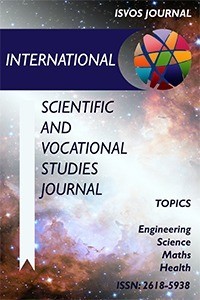ANN: Prediction of Heat Transfer and Flow Characteristics of a Tube with Modified Twisted Tapes
Heat transfer enhancement, fluid characteristics, ANN
ANN: Prediction of Heat Transfer and Flow Characteristics of a Tube with Modified Twisted Tapes
Heat transfer enhancement, fluid characteristics, ANN,
___
- [1] X. Zhang, Z. Liu and W. Liu, “Numerical studies on heat transfer and friction factor characteristics of a tube fitted with helical screw-tape without core-rod inserts,” International Journal of Heat and Mass Transfer, vol. 60, pp.490-498, 2013.
- [2] H. Gül and D. Evin, “Heat Transfer Enhancement in a Circular Tubes Using Helical Swirl Generator Insert at the Entrance,” International Jounal of Thermal Sciences, vol.46, pp. 1297-1303, 2007.
- [3] P. Murugesan, K. Mayilsamy and S. Suresh, “Turbulent Heat Transferand Pressure Drop in Tube Fitted with Square-cut Twisted Tape,” , Chinese Journal of Chemical Engineering, vol. 18, no. 4, pp. 609-617, 2010.
- [4] S. Güneş, V. Özceyhan and O. Büyükalaca, “Heat transfer enhancementin a tube with equilateral triangle cross sectioned coiled wire inserts,” Experimental Thermal and Fluid Science, vol. 34, no. 6, pp. 684-691, 2010.
- [5] R. Kamali, and A. R. Binesh, “ The Importance of Rib Shape Effects on the Local Heat Transfer and Flow Friction Characteristics of Square Ducts with Ribbed Internal Surfaces,” International Communications in Heat and Mass Transfer, vol. 35, no. 8, pp. 1032-1040, 2008.
- [6] S. Eimsa-ard, P. Nivesrangsan, S. Chokphoemphun and P. Promvonge, “Influence of combined non-uniform wire coil and twisted tape inserts on thermal performance characteristics,” International Communications in Heat and Mass Transfer , vol. 37, no. 7, pp. 850-856, 2010.
- [7] P. Sivashanmugam and P. K. Nagarajan, “Studies on Heat Transfer and Friction Factor Characteristics of Laminar Flow Through a Circular Tube Fitted with Right And Left Helical Screw-Tape Inserts,” Experimental Thermal and Fluid Science, vol. 32, pp. 192-197, 2007.
- [8] Kalogirou, S.A., “Applications of artificial neuralnetworks for energy systems”, Applied Energy, vol. 67, pp. 17-35, 2000.
- [9] S. Kmet, P. Sincak, P. Stehlik, “Artificial neural network for creep behavior predictions of a parallel-lay aramid rope under varying stresses”, Int. J. Exp. Mech., vol. 47, pp. 121–128, 2011.
- [10] S.P. Kyung, H.K. Soung, “Artificial intelligence approaches to determination of CNC machining parameters in manufacturing: a review”, Artif. Intell. Eng., vol. 12, pp. 121–134, 1998.
- [11] K.W. Chau, “A review on integration of artificial intelligence into water quality modelling”, Mar. Pollut. Bull., vol. 52, pp. 726–733, 2006.
- [12] S. Sanaye, H. Hajabdollahi, “Thermal-economic multi-objective optimization of plate fin heat exchanger using genetic algorithm”, Appl. Energy, vol. 87, pp. 1893–1902, 2010.
- [13] K. Varshney, P.K. Panigrahi, “Artificial neural network control of a heat exchanger in a closed flow air circuit”, Appl. Soft Comput., vol. 5, pp. 441–465, 2005.
- [14] T.N. Verma, P. Nashine, D. V. Singh, S. Singh and D. Panwar, “ANN: Prediction of an experimental heat transfer analysis of concentric tube heat exchanger with corrugated inner tubes,” Applied Thermal Engineering, vol. 120, pp. 219-227, 2017.
- [15] M. Hojjat, “Nanofluids as coolant in a shell and tube heat exchanger: ANN modeling and multi-objective optimization,” Applied Mathematics and Computation, vol 365, issue C,1-15, 2020.
- [16] M. Luy, U. Saray, “Wind speed estimation for missing wind data with three different backpropagation algorithms,” Energy Education Science and Technology Part A: Energy Science and Research, vol. 30, no. 1, pp. 45–54, 2012.
- [17] Göçmen, E , Derse, O . “Forecasting of Electricity Generation Shares by Fossil Fuels Using Artificial Neural Network and Regression Analysis in Turkey,” International Scientific and Vocational Studies Journal , 2 (2), 20-30, 2018.
- ISSN: 2618-5938
- Yayın Aralığı: Yılda 2 Sayı
- Başlangıç: 2017
- Yayıncı: Umut SARAY
Energy Sector Analysis with Fuzzy TOPSIS
ANN: Prediction of Heat Transfer and Flow Characteristics of a Tube with Modified Twisted Tapes
Aslı DURMUŞOĞLU, Sibel GÜNEŞ, Emrah ÖZAŞIR
Effect of Active Filler Ratio on Indirect Tensile Strenght of Foam Bituminous Mixtures
Kemal Muhammet ERTEN, Serdal TERZİ, Hüseyin AKBULUT
Structural Electronic and Dynamic Properties of Li3Pb
Sinem ERDEN GÜLEBAĞLAN, Emel KİLİT DOGAN
Changes in Crop and Irrigation Water Requirements in Niğde
The Importance of Creativity in Space Design
A Tabu Search Algorithm for an Excavator Scheduling Problem
Improved Whale Optimization Algorithm Based On π Number
